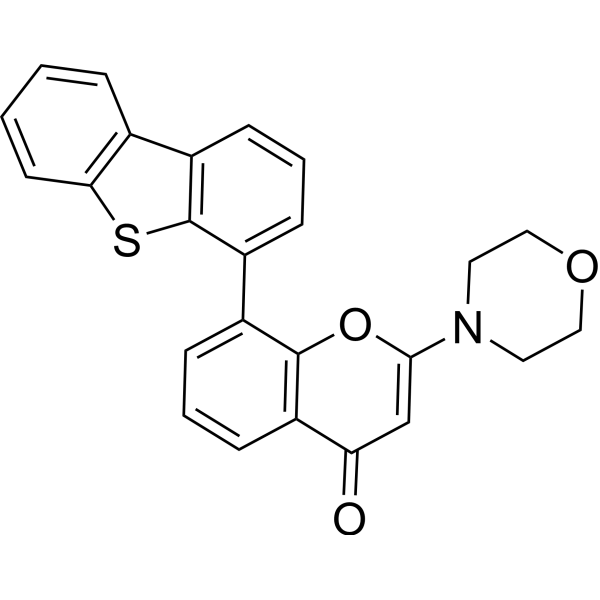Home
Products
NU7441 (KU-57788)



| Product Name | NU7441 (KU-57788) |
| Price: | Inquiry |
| Catalog No.: | CN00392 |
| CAS No.: | 503468-95-9 |
| Molecular Formula: | C25H19NO3S |
| Molecular Weight: | 413.49 g/mol |
| Purity: | >=98% |
| Type of Compound: | Alkaloids |
| Physical Desc.: | Powder |
| Source: | |
| Solvent: | Chloroform, Dichloromethane, Ethyl Acetate, DMSO, Acetone, etc. |
| SMILES: | O=c1cc(oc2c1cccc2c1cccc2c1sc1c2cccc1)N1CCOCC1 |
| Contact us | |
|---|---|
| First Name: | |
| Last Name: | |
| E-mail: | |
| Question: | |
| Description | KU-57788 is a potent and selective inhibitor of DNA-PK with an IC50 of 13 nM, with selectivity over a range of kinases including mTOR, PI 3-K, ATM and ATR. |
| Target | DNA-PK:13 nM (IC50) CRISPR/Cas9 |
| In Vitro | NU7441 at non-toxic concentration of 0.3 μM induces radio-sensitization in non-small cell lung cancer cells irradiated with low-LET and high-LET radiation, and does not show double strand break-repair inhibition in irradiated cells. NU7441 (3 μM) shows significantly increased persistent γ-H2AX signals. NU7441 (0.3 μM) causes significant G2/M arrest and a remarkable increase of DNA fragmentation and enhances cellular senescence in irradiated H1299 cells[1]. NU7441 (0.5 to 10 µM) inhibits the growth of liver cancer HepG2 cells dose- and time-dependently. NU7441 reduces pDNA-PKcs (S2056) protein expression in liver cancer cells. Furthermore, double treatment of NU7441 and 60Coγ IR affects DNA damage repair[2]. NU7441 is solvent-exposed in BRD4, this inhibitor can be classified as a Type I BRD inhibitor[4]. NU7441 reduces the frequency of NHEJ while increasing the rate of HDR following Cas9-mediated DNA cleavage[5]. |
| In Vivo | lung cancer cells irradiated with low-LET and high-LET radiation, and does not show double strand break-repair inhibition in irradiated cells. KU-57788 (3 μM) shows significantly increased persistent γ-H2AX signals. KU-57788 (0.3 μM) causes significant G2/M arrest and a remarkable increase of DNA fragmentation and enhances cellular senescence in irradiated H1299 cells[1]. KU-57788 (0.5 to 10 µM) inhibits the growth of liver cancer HepG2 cells dose- and time-dependently. KU-57788 reduces pDNA-PKcs (S2056) protein expression in liver cancer cells. Furthermore, double treatment of KU-57788 and 60Coγ IR affects DNA damage repair[2]. KU-57788 weakly inhibits BRD4 and BRDT with IC50s of 1 μM and 3.5 μM, respectively. KU-57788 is solvent-exposed in BRD4, this inhibitor can be classified as a Type I BRD inhibitor[4]. KU-57788 reduces the frequency of NHEJ while increasing the rate of HDR following Cas9-mediated DNA cleavage[5]. |
| Cell Assay | HepG2 cells (4000 per well) are cultured in a 96-well plate for 24 h. Once the cells complete the attachment, 0.1 µM, 1 µM, 5 µM, and 10 µM of KU-57788 are added to the culture media. After 12 h of KU-57788 treatment, 10% CCK-8 solution is added into the culture media, and the incubation continued for two h. OD450 values are determined by a spectrometer, and the results are analyzed to measure the cell growth. |
| Density | 1.4±0.1 g/cm3 |
| Boiling Point | 646.9±55.0 °C at 760 mmHg |
| Flash Point | 345.0±31.5 °C |
| Exact Mass | 413.108551 |
| PSA | 70.92000 |
| LogP | 5.98 |
| Vapour Pressure | 0.0±1.9 mmHg at 25°C |
| Storage condition | Store at +4°C |